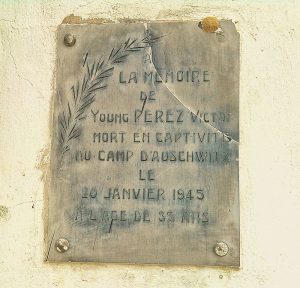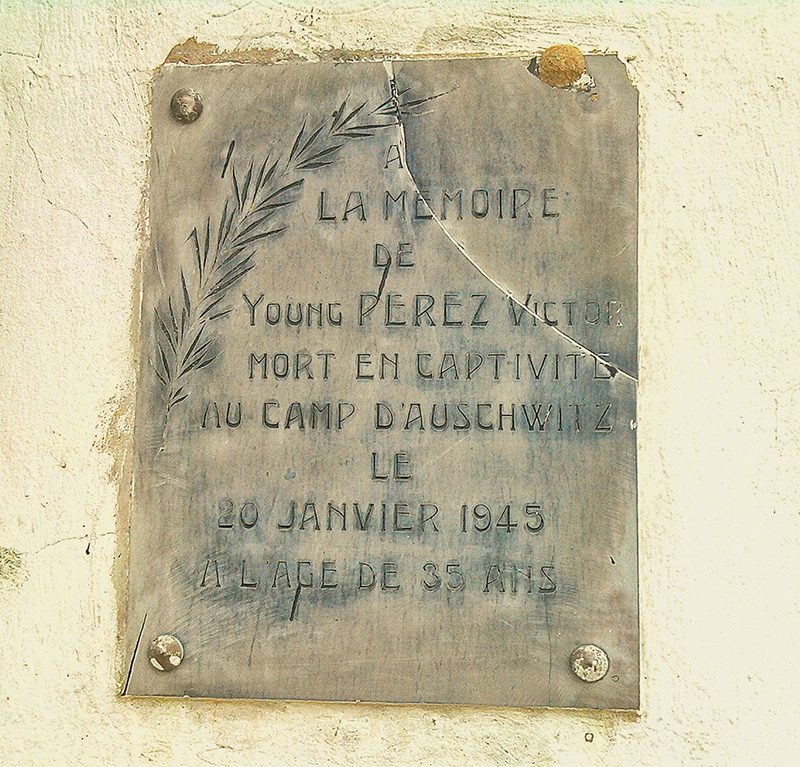The Jewish presence in Tunisia dates to the 2nd century BC. Under the Vichy regime in 1940, Tunisian Jews were subjected to antisemitic laws and restrictions. The German occupation, dating from November 1942 to May 1943, further intensified persecution. Approximately 5,000 Jewish men were sent to forced labor and internment camps. The Tunisian campaign of 1943 put an end to the German occupation, but Vichy’s antisemitic legislation persisted until the end of the regime in 1944.
The Holocaust in Tunisia
The Jewish community of Tunisia has existed since the second century BCE, dating back to Carthage. [1] The Jewish community of Tunis gradually increased during the 11th century, but the Almohad[2] conquest in the 12th century interrupted this growth. After seizing Tunis, the Almohad Caliph Abd al-Mu’min forced both Jews and Christians to convert to Islam. However, during the 13th century, the Hafsid dynasty restored the status of dhimmi (status accorded to non-Muslims under which they had to pay a tax to the Muslim state for protection) to Jews and Christians. Jews were able to regroup in communities and openly practice their religion again. Some returned to the city of Tunis and resettled in the Hara, a district reserved for the Jewish community. [3]
The establishment of the French protectorate in 1881 improved the situation of the Jewish community, although discriminatory episodes still occurred. With the French revolutionary promise of Liberté, égalité, and fraternité, many Tunisian Jews began identifying with French culture in the hope that their inferior status as dhimmi could improve with the French protectorate. Nevertheless, their situation shifted drastically in 1940 when the Vichy regime came to power .[4]
Vichy France
Tunisia, like Morocco and Algeria, was in the hands of Vichy France following its establishment in July 1940. The antisemitic and racist legislation that Vichy had imposed in hexagonal France was gradually extended to its colonies in North and West Africa. Such legislation denied Algerian Jews their French citizenship and deprived some North African Jews of property, businesses, and assets while imposing quotas on many professions. It is important to note that these laws were not implemented consistently throughout North Africa. [5] Morocco and Tunisia, for instance, had protectorate status. Although restricted from imposing Vichy laws through decrees, the Sultan Muhammad V, and the Bey of Tunisia, Muhammad VII al-Munsif, did try to protect the Jewish population to varying degrees.[6]
In Tunisia, the Vichy French administration enacted multiple restrictions and forms of discrimination, although unevenly and sporadically. These include the enforcement of the compulsory Jewish census in September 1941 and the establishment of the Commissariat Général aux Questions Juives.[7] The occupation of the country by German troops in November 1942 fortified Vichy’s discriminatory measures and the implementation of new antisemitic policies.
German Occupation
Tunisia was the only North African country to come under Nazi Germany’s occupation from November 1942 to May 1943. The Nazis began persecuting Jews in Tunisia as early as two weeks after their invasion, arresting leaders of the Jewish community.[8] These antisemitic actions were amplified by round-ups, raids, starvation, wartime violence, and racially discriminatory laws.
Alongside the Vichy French collaborators and their Italian Fascist allies, the Nazis also imposed many antisemitic policies in Tunisia that controlled the movement of Jews. Among other measures, thousands of Jews in the country were forced to wear yellow stars and the Comité de Recrutement de la Main-d’Oeuvre Juive supplied forced laborers. While the Nazis were prepared to implement the systematic murder of the Jews of Tunisia, with the presence of the Einsatzkommando (a sub-group of mobile Nazi killing units) led by the SS commander Walter Rauff, time constraints, lack of resources, and the evolution of the war limited their plan of persecution. The discriminatory measures introduced by Vichy nevertheless secured the slippery slope from which the German occupation worsened conditions.[9]
In total, approximately 5,000 Jewish men were sent to forced labor and internment camps in Tunisia.[10] To this number must be added the many women, men, and children who suffered from the occupation’s difficult conditions, harassment, physical and sexual violence, arrests, internments, and pillaging. [11] This is the case of Gilbert-Mardochée Mazouz, who at the age of 19 was killed by a German soldier on his way to the Cheylus camp, near Tunis. [12] Cases of Tunisian Jews who moved to Europe before the war and were deported to Nazi concentration camps and killing centers should also be considered. Messaoud Hai Victor Perez, a Tunisian boxer who was detained in the Drancy internment camp and deported to Auschwitz, was one of them. Forced by the SS to participate in several boxing matches in Auschwitz, he was later killed during a death march on January 21, 1945, after trying to share bread with his fellow inmates. [13]
The Tunisian campaign and the capture of Tunisia by the Allied forces in May 1943 led the Axis forces to surrender. Although Tunisia was freed from Germany and its Axis forces, the country was still under French colonial rule. Under the command of the Free French High Commissioner General Henri Giraud, the antisemitic legislation of the Vichy regime was maintained until 1944. Many of the Vichy camps, including the forced labor camps in the Sahara, continued to operate, sometimes with the same wartime overseers in place.[14] Various prisoners were imprisoned in these camps, including Tunisian Jews and Muslims, European refugees, anti-colonial activists, as well as conscripts from West and North Africa.[15]

Commemorative plaque in memory of Young Perez, a famous Jewish boxer from Tunisia,
at the Borgel cemetery in Tunis. He survived Auschwitz but was shot
by the Nazis during a death march after the evacuation of the camp in 1945.© Xklee, CC
Learn more about the Holocaust in Tunisia
To improve your knowledge of the Holocaust in Tunisia, you can watch the recorded testimonies from the following survivors: Roger Abitbol on our Survivors’ Stories page, as well as Myriam Moatti, Gilbert Uzan, and Gisèle Braka on our YouTube channel.
Do not forget to use our Testimony Analysis Sheet when watching the videos with your students in the classroom.
References
- Borgel. Robert. Étoile jaune et croix gammée (Paris : Mémorial de la Shoah. Collection Témoignage de la Shoah, 2007)
- Boum, Aomar and Sarah Abrevaya Stein (eds.) Wartime North Africa: a documentary history, 1934-1950 (Redwood City: Stanford University Press, 2021)
- Brozgal, Lia. “The Ethics and Aesthetics of Restraint: Judeo-Tunisian Narratives of Occupation” in Aomar Boum and Sarah Abrevaya Stein (eds.) The Holocaust and North Africa (Redwood City: Stanford University Press, 2018)
- Lee, Daniel. “The Commissariat Général aux Questions Juives in Tunisia and the Implementation of Vichy’s Anti-Jewish Legislation” in Aomar Boum and Sarah Abrevaya Stein (eds.) The Holocaust and North Africa (Redwood City: Stanford University Press, 2018)
- Schroeter, Daniel J. “Between Metropole and French North Africa Vichy’s Anti-Semitic Legislation and Colonialism’s Racial Hierarchies,” in Aomar Boum and Sarah Abrevaya Stein (eds.) The Holocaust and North Africa (Redwood City: Stanford University Press, 2018)
- European Jewish Congress, “Tunisia,” [Online Ressource]; https://eurojewcong.org/communities/tunisia/
- Institut de recherche et d’études Méditerranée Moyen-Orient, « Les Juifs de Tunisie. Quelques repères historiques, » Online Ressource]; https://iremmo.org/wp-content/uploads/2016/02/1020.juif_.pdf
- Jimena Tunisian Experience, “Jewish History,” [Online Ressource]; http://jimenaexperience.org/tunisia/about/jewish-history/
- Nataf, Claude. « Rencontre : 75 ans après la rafle de Tunis du 9 décembre 1942», Mémorial de la Shoah et Société d’histoire des Juifs de Tunisie, [Online Resource]; https://www.youtube.com/watch?v=u6KibKBRXbo
- Ochayon, Sheryl Silver. “The Jews of Algeria, Morocco and Tunisia,” Yad Vashem [Online Resource]; https://www.yadvashem.org/articles/general/the-jews-of-algeria-morocco-and-tunisia.html
- Satloff, Robert. “The Arabs Watched Over the Jews,” in Among the Righteous. Lost Stories from the Holocaust’s Long Reach into Arab Lands in USHMM [Online Resource]; https://www.ushmm.org/m/pdfs/20061207-satloff-english-chapter-5.pdf
- World Jewish Congress, “Community in Tunisia,” [Online Ressource]; https://www.worldjewishcongress.org/en/about/communities/TN
- Yad Vashem, “Tunisia,” Shoah Resource Center Online Resource]; https://www.yadvashem.org/odot_pdf/Microsoft%20Word%20-%205892.pdf

